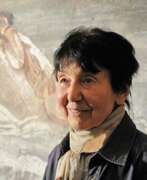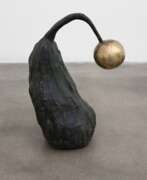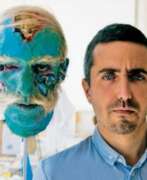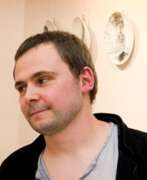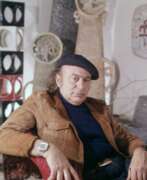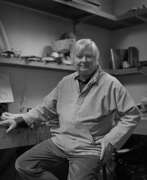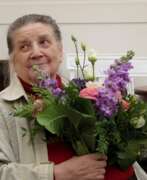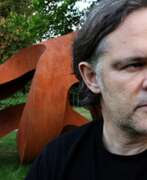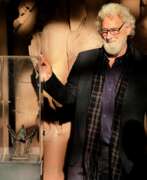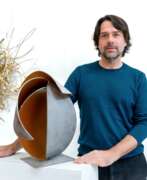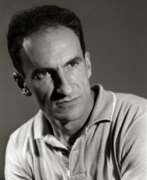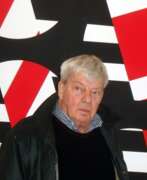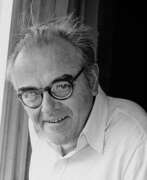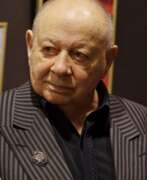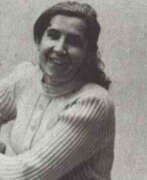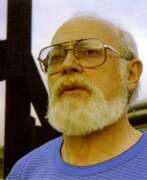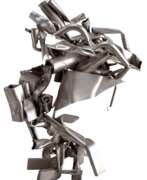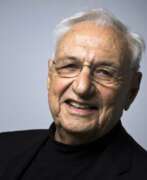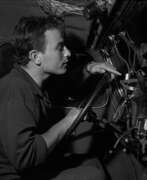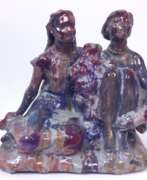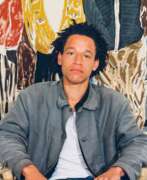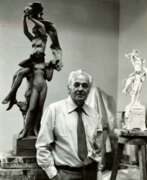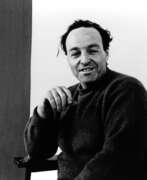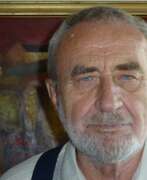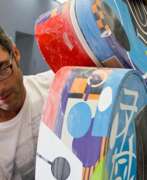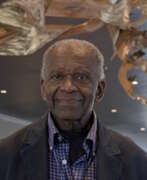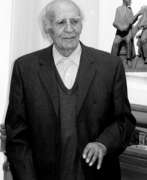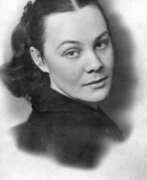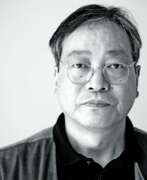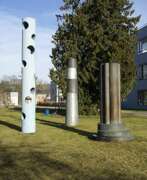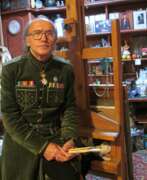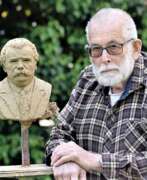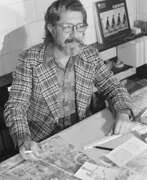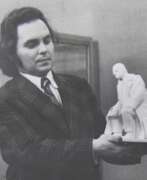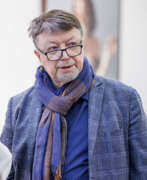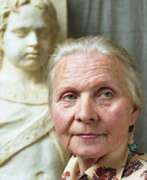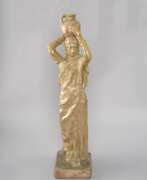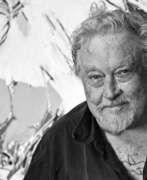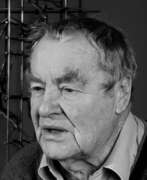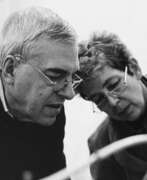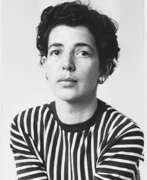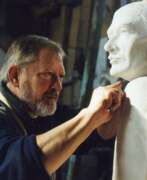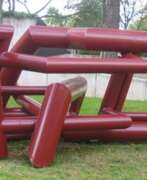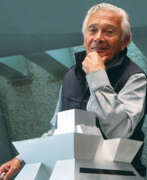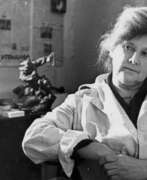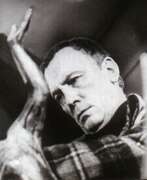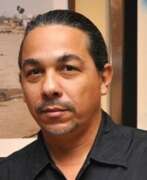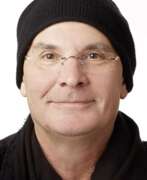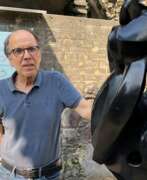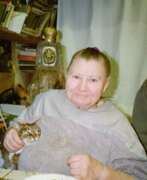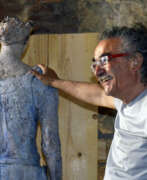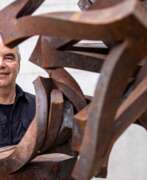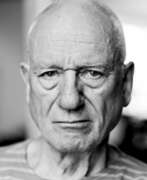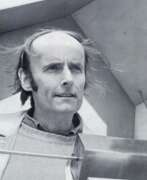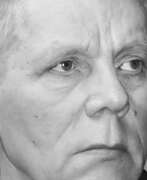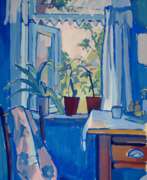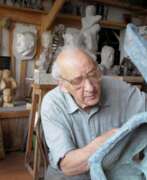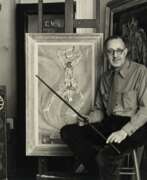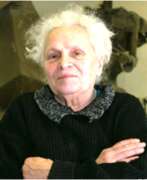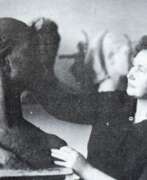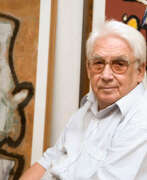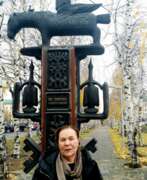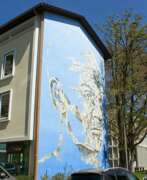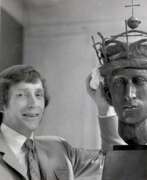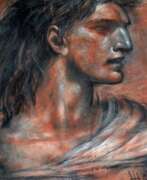Monumentalists Contemporary art
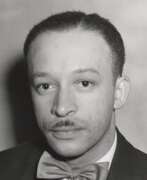

Charles Henry Alston was a mid-twentieth-century American artist. He is known as a graphic and muralist painter as well as a sculptor, illustrator, and educator who lived and worked in New York City's Harlem neighborhood.
Charles Alston was an activist in the so-called "Harlem Renaissance." He became the first African-American director of the U.S. Federal Art Project. The artist created murals for Harlem Hospital as well as a number of cultural and administrative buildings in New York City. Alston is the author of a bust of Martin Luther King, Jr. which was the first depiction of an African American to be displayed at the White House in Washington, DC.
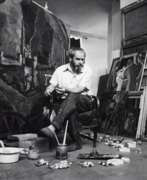

Nikolai Ivanovich Andronov (Russian: Николай Иванович Андронов) was a Soviet artist of the second half of the twentieth century. He is known as a painter, muralist and teacher, considered one of the founders of the "severe style" in the art of the USSR.
Nikolai Andronov actively worked to liberalize the Soviet art scene. At the beginning of his career, he created thematic paintings, later focusing on landscapes. The artist was also involved in the decoration of buildings, including the clubhouse of the Soviet Embassy in the United States, the Paveletsky Railway Station and subway stations in Moscow. From 1992, he taught at the Surikov Moscow Art Institute and headed the composition department.
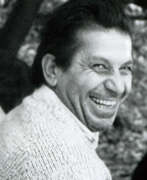

Robert Petrosovich Avakyan (Russian: Роберт Петросович Авакян) was a Soviet and Uzbek artist of the second half of the twentieth and early twenty-first centuries of Armenian origin. He is known as a painter, graphic artist, sculptor and teacher.
Robert Avakyan was trained in painting, but he is most famous as an author of monumental sculptures. He worked actively in Tashkent, participating in numerous exhibitions, including international sculpture competitions. The master also left his mark in such Uzbek cities as Bukhara, Nukus and Yangibazar, where he created significant monumental works.
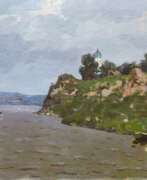

Yakov Tarasovich Besperstov (Russian: Яков Тарасович Бесперстов) was a Russian Soviet artist of the second half of the twentieth century. He is known as a painter, muralist, representative of the Leningrad school of painting.
At the initial stage of his career, Yakov Besperstov worked in the field of monumental and decorative painting, participating in the painting of various buildings. Later he moved to easel painting, creating portraits, genre paintings, as well as urban landscapes. His works were exhibited at exhibitions from the late 1950s and were appreciated by leading artists of Leningrad. The master traveled extensively throughout various regions of Russia and other countries, including France.
His works are in museums and private collections in various countries, including Russia, France, Belgium, Germany, Spain and Italy.
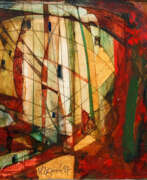

Ivan Ivanovich Chorny (Russian: Иван Иванович Чёрный) was a Soviet, Ukrainian and Russian artist of the second half of the twentieth and early twenty-first centuries. He was known for his monumental and decorative works in the style of socialist realism.
Ivan Chorny reoriented his style in the late 1990s, inventing a new technique and moving away from figurativeness in favor of abstract painting. His enigmatic compositions became an expressive expression of inner feelings enriched with colors and lines.
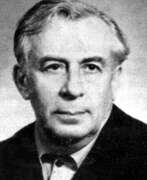

Isaac Aronovich Davidovich (Russian: Исаак Аронович Давидович) was a Soviet and Belarusian artist of Jewish origin of the second half of the twentieth century. He is known as a painter and graphic artist.
Isaac Davidovich worked in easel and monumental and decorative painting, as well as in easel and book graphics, he drew illustrations and posters. In the field of monumental art he created plafonds and panels.
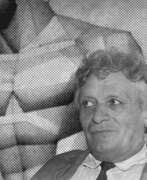

Valery Arutyunovich Geghamyan (Russian: Валерий Арутюнович Гегамян) was a Soviet and Ukrainian artist of the mid-twentieth century of Armenian origin. He is known as a painter, graphic artist and teacher.
Valeriy Geghamyan became famous for his monumental canvases, large thematic cycles and graphic series. He also created portraits, landscapes and still lifes. Since the early 1960s he lived and worked in Odessa and founded the art and graphic arts faculty at the Odessa Pedagogical Institute, where he taught for more than 20 years. The master raised many famous artists, some of whom are also teachers, passing on the experience of their teacher.


Oswaldo Guayasamín is an Ecuadorian painter, muralist and sculptor.
Oswaldo's father was an Indian, and the family was very poor, but the future artist was educated at the School of Fine Arts of Quito. Soon, literally in two years, he created a cycle of 103 paintings dedicated to the life of oppressed Indians in Latin America. Oswaldo Guayasamin also painted portraits of famous contemporaries, including Fidel Castro, whom he admired. He also created murals, frescoes, landscapes, and symbolic images.
The artist's works were exhibited in Paris, Moscow and in Leningrad, among other cities around the world, with amazing success. In 1957, at the Fourth Biennial in São Paulo, he was named the best South American artist.
Guayasamin was also a passionate collector. In 1978, the then famous artist donated to the State of Ecuador some 500 colonial paintings and sculptures, pre-Columbian archaeological sites, Goya and Picasso paintings that he had collected.
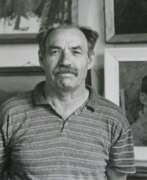

Theodor Theodorovich Herzen (Russian: Теодор Теодорович Герцен) was a Soviet and Kyrgyz artist of the second half of the twentieth and early twenty-first centuries of German origin. He is known as a painter, graphic artist, muralist, who was honored with the title of People's Artist of Kyrgyzstan.
Theodor Herzen worked in monumental and decorative art, easel painting and book graphics. One of Herzen's outstanding works was a monumental cycle of illustrations to the Kyrgyz epic "Manas", including more than two hundred linocuts. In this project, he combined his extensive experience of working on Kyrgyz themes with his deep knowledge of the ethnicity, history and spiritual traditions of the Kyrgyz people. Herzen collected extensive ethnographic material and created many sketches of costumes and scenes from Kyrgyz life for this cycle of illustrations.
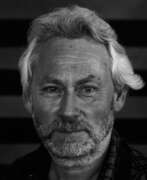

Donald Clarence Judd was an American artist associated with minimalism (a term he nonetheless stridently disavowed). In his work, Judd sought autonomy and clarity for the constructed object and the space created by it, ultimately achieving a rigorously democratic presentation without compositional hierarchy. He is generally considered the leading international exponent of "minimalism," and its most important theoretician through such writings as "Specific Objects" (1964). Judd voiced his unorthodox perception of minimalism in Arts Yearbook 8, where he says, "The new three dimensional work doesn't constitute a movement, school, or style. The common aspects are too general and too little common to define a movement. The differences are greater than the similarities."
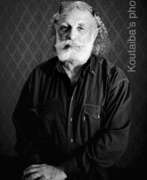

Nida Kadhim is an Iraqi sculptor, noted for producing a number of monumental works for Baghdad's city centre, some of which are still standing, while others were demolished or looted following the 2003 Iraqi invasion. Kadhim received his formal art education at Baghdad's Academy of Fine Arts in the 1950s. Actively involved in the Iraqi arts community, he became a founding member of the art group known as Al-Mujadidin (The Innovationists). His sculptures focus on grandiose busts and statues of leading figures taken from Iraq's history, or are based on other themes the artist considers worthy. His most well-known sculpture, which is still standing, is the Arab Woman in Zawra Park, Baghdad. It depicts an Arab woman holding a bouquet of flowers out to the new generation of Iraqis who are seeking a better future.
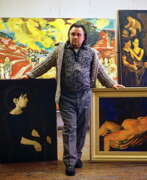

Alexander Mikhailovich Kishchenko (Russian: Александр Михайлович Кищенко) was a Soviet and Belarusian artist of the second half of the twentieth century. He is best known as a muralist painter.
Alexander Kishchenko is considered one of the most famous artists of Belarus of the 20th century, and his works are valuable assets of Belarusian culture. He worked in all genres of easel and monumental decorative painting and created hundreds of works during his career, including philosophical paintings and portraits. The artist was also proficient in mosaics, ceramics and tapestry.
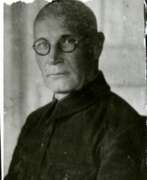

Georgy Dmitrievich Lavrov (Russian: Георгий Дмитриевич Лавров) was a Russian and Soviet sculptor of the twentieth century. He is known as a portraitist, monumentalist, animalist and representative of the Art Deco style.
Georgy Lavrov created propaganda posters at the beginning of his career in collaboration with poet Vladimir Mayakovsky. He then developed his style during a business trip to Paris under the influence of the French animalist sculptor François Pompon. Returning from France in 1935, he created the famous sculptural composition "Thank you Comrade Stalin for our happy childhood!". However, in 1938 the artist was arrested and convicted, served his sentence in the camps, and in 1954 was rehabilitated.
Lavrov left a significant artistic legacy.
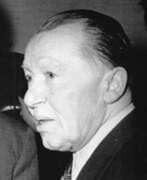

Max Lingner was a German artist of the first half of the twentieth century. He is known as a painter, graphic artist, muralist and teacher.
Max Lingner at the beginning of his career, studying in Paris, was influenced by Impressionism. He worked as a painter and engraver for the newspaper Le Monde. Joining the French Communist Party, Lingner fought on the Republican side during the Spanish Civil War and fought against the Nazis in the Resistance Movement in France. After returning to the GDR, he became a professor and created the monumental panel "Building the Republic" in the House of Ministers. The artist donated the 40 paintings, prints and watercolors he had brought back to the state.
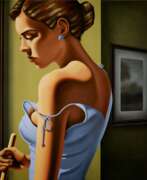

Kenton Nelson is an American muralist, graphic designer, illustrator and educator.
A graduate of California State University, Nelson also studied at Otis College of Art and Design in Los Angeles, California. He later taught there as well.
He first worked as a graphic designer and illustrator for many years before he began painting in the style of modern realism. In his paintings, one can see the influence of 1950s American advertising and pop art. Nelson also creates wall murals. In 2005, he published a two-volume set of art books entitled Rhyme and Reason, Prose and Minuses.
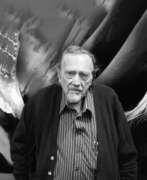

Leonardo Nierman, full name Leonardo Nierman Mendelejis, is a Mexican artist known mainly for his paintings and sculptures. His work is abstract yet still contains visible images of nature such as birds, water, lightning and more. His paintings are in pure colours, while his sculptures are usually in metal, often with a silver hue.
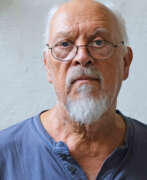

Karl Ulrich Nuss is a German artist and sculptor who creates large-scale bronze compositions.
His father was the sculptor Fritz Nuss (1907-1999), Karl Ulrich Nuss continued his work and developed an unmistakable design style that characterizes all his sculptures. They depict single people, couples, families, as well as new fantastical creations from the animal kingdom. These works can be seen in public spaces in Bochum, Frankfurt/Main and Stuttgart.
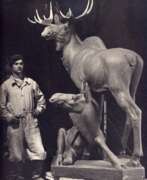

Georgy Nikolaevich Popandopulo (Russian: Георгий Николаевич Попандопуло) was a Soviet artist of the second half of the twentieth century. He is known as an animal sculptor, famous for his monumental and easel works.
Georgy Popandopulo began his independent career in 1959, creating park sculptures and souvenirs for the Art Fund of the RSFSR. His monumental animalistic works are installed in various Russian cities. Popandopulo's works are kept in renowned museums in Russia and abroad, including the State Tretyakov Gallery and the State Russian Museum.
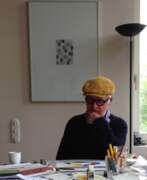

Ulrich Rückriem is a German sculptor known for his large-scale stone sculptures that are often displayed in public spaces. He studied at the Werkkunstschule Krefeld and the Kunstakademie Düsseldorf.
Rückriem's early work was influenced by the Minimalist movement, and he became known for creating abstract, geometric sculptures from raw stone blocks. He often works with granite, basalt, and other types of hard stone, using traditional carving techniques to shape and refine his forms.
In the 1970s, Rückriem began creating large-scale public installations, including his "Stone Alignments" series, which consists of rows of standing stones that evoke ancient megaliths and other prehistoric monuments. His work often engages with the natural environment, creating a dialogue between the man-made and the organic.
Rückriem has exhibited his work in museums and galleries around the world, including the Tate Gallery in London, the Solomon R. Guggenheim Museum in New York, and the Kunstmuseum Bonn in Germany. He has also received numerous awards and honors for his contributions to the field of sculpture, including the International Sculpture Prize in 1987 and the Praemium Imperiale in 2010.
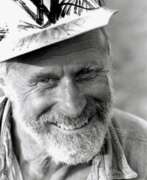

Marco Polo di Suvero, better known as Mark di Suvero, is an abstract expressionist sculptor and 2010 National Medal of Arts recipient.
Mark di Suvero gained an almost instant recognition among art critics with his first solo exhibit at the Green Gallery in the fall of 1960. His early works were large outdoor pieces that incorporated wooden timbers from demolition buildings, tires, scrap metal, and structural steel. This exploration has transformed over time into a focus on H-beams and heavy steel plates. Many of the pieces contain sections that are allowed to swing and rotate giving the overall forms a considerable degree of motion. Di Suvero pioneered the use of a crane as a sculptor's working tool.
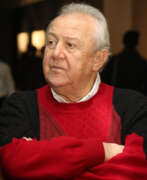

Zurab Konstantinovich Tsereteli (Russian: Зураб Константинович Церетели), a Georgian-Russian artist renowned for his monumental sculptures, has left an indelible mark on the landscape of modern art. Born in Tbilisi in 1934, Tsereteli expanded his artistic vision beyond painting after moving to Paris in the 1960s, where he was influenced by luminaries such as Picasso and Chagall. His work is characterized by a blend of dramatic, unconventional styles that have spurred debate but undeniably contributed to the cultural fabric of cities around the world.
Tsereteli's artworks, ranging from sculptures to paintings, are displayed globally, embodying his ethos that "art unites people." Noteworthy projects include the Peter the Great statue in Moscow, the Birth of the New Man in Seville, Spain, and the Tear of Grief in Bayonne, New Jersey, a poignant memorial to the victims of the 9/11 attacks. His commitment to fostering international cultural exchanges is evident in his role as the President of the Russian Academy of Arts and a UNESCO Goodwill Ambassador.
Beyond his public commissions, Tsereteli's contributions to education and the arts are profound. He founded the Moscow Museum of Modern Art and the Museum of Modern Art in Tbilisi, promoting modern and contemporary art in Russia and Georgia. His dedication to the Russian Academy of Arts underscores his belief in the importance of nurturing artistic talent and preserving the heritage of the academic school of fine arts.
For collectors and experts in art and antiques, Tsereteli's oeuvre offers a unique investment in pieces that are not only visually striking but also rich with cultural significance. His work encapsulates the dynamic interplay between traditional and contemporary art forms, making each piece a testament to his lifelong dedication to artistic innovation and cross-cultural dialogue.
To stay updated on new exhibitions, sales, and auction events related to Zurab Konstantinovich Tsereteli, sign up for updates. This subscription is a gateway to the latest developments in the world of a towering figure in art, offering exclusive insights into his ongoing contributions to the global art scene.
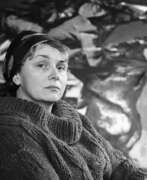

Sofija Veiveryte (Russian: София Мотиевна Вейверите) was a Lithuanian and Soviet artist of the second half of the twentieth and early twenty-first centuries. She is known as a painter, graphic artist, master of frescoes, and teacher.
Sofija Veiveryte created works characterized by monumentality, expressiveness, ability to work with tones and halftones. Her portraits show the influence of the old Renaissance and Baroque masters. Her works are kept in various museums, including the Tretyakov Gallery, the Pushkin Museum of Fine Arts, the Sofia National Gallery (Bulgaria) and the Lithuanian Museum of Theater, Music and Cinema, as well as in private collections.
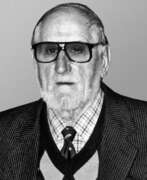

Rostislav Ivanovich Vovkushevsky (Russian: Ростислав Иванович Вовкушевский) was a Soviet and Russian artist of the second half of the twentieth century. He is known as a painter, muralist and teacher, a representative of the Leningrad school.
Rostislav Vovkushevsky actively exhibited his works since 1949. He worked in both easel and monumental painting, his work included still lifes, portraits, landscapes and genre compositions. Important works of the artist were monumental panels, mosaic compositions and ceremonial curtains for auditoriums. His style was distinguished by decorative elements, clear silhouettes and rich color, as well as rhythmic organization of the canvas.
His works are in museums and private collections around the world.
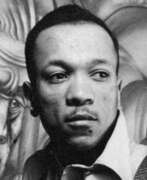

Charles Wilbert White, Jr. was a mid-twentieth-century American artist. He is known as a painter, graphic artist, lithographer, muralist, and educator.
Charles White, Jr. is considered one of the most famous artists in the history of African American art in the United States. Throughout his life, he reflected the life and struggles of the black community in his paintings, drawings, lithographs and murals. After White's death, his work was included in the permanent collections of leading American art museums and galleries.
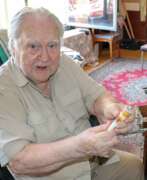

Vitaly Georgievich Yablonovsky-Snadzsky (Russian: Виталий Георгиевич Яблоновский-Снадзский) is a Soviet and contemporary Russian artist. He is known as a painter specializing in landscapes and still lifes.
Vitaly Yablonovsky-Snadzsky is also known for his monumental paintings of sanatoriums in Sochi, where he lives permanently. He has been actively creating since the early 1970s. Among his most famous works are the paintings "Gifts of Autumn", "Red Poppies", "Dry Grasses", "Clusters of Rowanberries", "Crayfish" and others.
His works are in museums and private collections in Russia and other countries - in Germany, Poland, Yugoslavia, Finland, Syria, France, Spain, USA, Turkey.
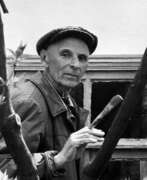

Sergei Efimovich Zakharov (Russian: Сергей Ефимович Захаров) was a Soviet artist of the twentieth century. He is known as a painter, graphic artist, watercolorist, designer, artist of monumental and decorative art and architect. For his work in Tajikistan he was awarded the title of Honored Art Worker of the Tajik SSR.
Sergei Zakharov worked on many projects during his career, including the decoration of theaters, government buildings and libraries in Tajikistan, as well as interior designs for Soviet motor ships. He also practiced easel painting and graphics, creating landscapes, still lifes and thematic works.
His works are in various museums, including the State Tretyakov Gallery and the State Russian Museum.
